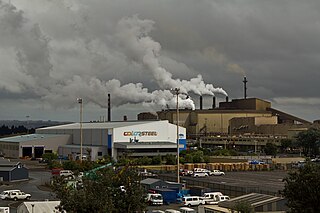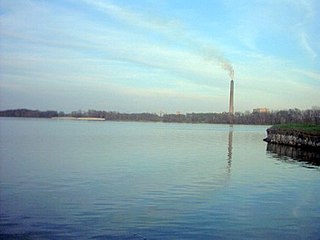
Think Big was an interventionist state economic strategy of the Third National Government of New Zealand, promoted by the Prime Minister Robert Muldoon (1975–1984) and his National government in the early 1980s. The Think Big schemes saw the government borrow heavily overseas, running up a large external deficit, and using the funds for large-scale industrial projects. Petrochemical and energy related projects figured prominently, designed to utilise New Zealand's abundant natural gas to produce ammonia, urea fertiliser, methanol and petrol.
The HVDC Inter-Island link is a 610 km (380 mi) long, 1200 MW high-voltage direct current (HVDC) transmission system connecting the electricity networks of the North Island and South Island of New Zealand together. It is commonly referred to as the Cook Strait cable in the media and in press releases, although the link is much longer than its Cook Strait section. The link is owned and operated by state-owned transmission company Transpower New Zealand.

Glenbrook is a rural and industrial area in the Auckland region of New Zealand. The industrial area, that of New Zealand's major steel mill, New Zealand Steel, is not located close to any towns - the surrounding countryside is occupied by farms. The nearest towns are Waiuku, five kilometres to the south, and Pukekohe, 15 kilometres to the east.

New Zealand Steel Limited is the owner of the Glenbrook Steel Mill, a steel mill located 40 kilometres south of Auckland, in Glenbrook, New Zealand. The mill was constructed in 1968 and began producing steel products in 1969. Currently, the mill produces 650,000 tonnes of steel a year, which is either used domestically or exported. Over 90% of New Zealand's steel requirements are produced at Glenbrook, while the remaining volume is produced by Pacific Steel, a steel recycling facility in Ōtāhuhu, Auckland. The mill is served by the Mission Bush Branch railway line, which was formerly a branch line to Waiuku. Coal and lime trains arrive daily. Steel products are also transported daily. The mill employs 1,150 full-time staff and 200 semi-permanent contractors.

The Vallecitos Nuclear Center is a nuclear research facility, and the site of a former GE Hitachi Nuclear Energy electricity-generating nuclear power plant in unincorporated Alameda County, California, United States. The facility is approximately 30 miles (48 km) east of San Francisco, under jurisdiction of the US Nuclear Regulatory Commission's Region IV.

The Glenbrook Vintage Railway (GVR) is a heritage steam railway in Glenbrook, New Zealand.

The Gibson Generating Station is a coal-burning power plant located at the northernmost end of Montgomery Township, Gibson County, Indiana, United States. It is close to the Wabash River, 1.5 miles (2.5 km) southeast of Mount Carmel, Illinois, 2 miles (3.2 km) south of the mouth of the Patoka River, and 4 miles (6.5 km) south of the mouth of the White River. The closest Indiana communities are Owensville 7.5 miles (12 km) to the southeast of the plant, and Princeton, 10.5 miles (17 km) to the east. With a 2013 aggregate output capacity among its five units of 3,345 megawatts, it is the largest power plant run by Duke Energy, and the tenth-largest electrical plant in the United States. Given the closure of the Nanticoke Generating Station in Ontario, in 2013, the Gibson Generating Station became the largest coal power plant in North America by generated power.
Rotowaro was once a small coal mining township approximately 10 km west of Huntly in the Waikato region of New Zealand. The town was built especially for miners houses, but was entirely removed in the 1980s to make way for a large opencast mine.

Geothermal power is electrical power generated from geothermal energy. Technologies in use include dry steam power stations, flash steam power stations and binary cycle power stations. Geothermal electricity generation is currently used in 26 countries, while geothermal heating is in use in 70 countries.

The Aviemore Dam is a dam on the Waitaki River in New Zealand. The dam is a composite dam, with an embankment section, and a concrete section. Built in the 1960s it impounds Lake Aviemore.
The electricity sector in New Zealand uses mainly renewable energy, such as hydropower, geothermal power and increasingly wind energy. As of 2019, 82% of electricity is generated from renewable sources, making New Zealand one of the countries with the lowest carbon dioxide emissions from electricity generation. Electricity demand grew by an average of 2.1% per year from 1974 to 2010 but decreased by 1.2% from 2010 to 2013.
The Pātea Dam is a high compacted earth fill–type hydroelectric dam in Taranaki, New Zealand, constructed between 1980 and 1984.
Bullendale is an abandoned mining settlement in Otago, New Zealand. It is the site of New Zealand's first industrial hydro-electric power plant. Located in rugged and remote countryside, it has survived to become of historical significance, and several archaeological surveys have been conducted there.

Horahora Power Station was an early hydroelectric power station on the Waikato River in New Zealand. It was the country’s first large-scale power station, completed in 1913. Initially built to service a gold mine, the power station was expanded to supply a significant part of the North Island. The power station remained in use until it was submerged by Lake Karapiro, which was formed to supply the larger Karapiro Power Station.
Nga Awa Purua, also known as Rotokawa II, is a geothermal power station located near Taupō in New Zealand. The project was developed by Mighty River Power. Nga Awa Purua is New Zealand's second largest geothermal power station and the steam turbine is the largest geothermal turbine in the world.

Ātiamuri Power Station is a hydroelectric power station on the Waikato River, in the North Island of New Zealand. It is the third of eight hydroelectric power stations on the Waikato River. The station can easily be seen from State Highway 1 between Taupō and Tokoroa.
Maraetai Power Station is a hydroelectric power station on the Waikato River, in the North Island of New Zealand. It is the fifth of the eight hydroelectric power stations on the Waikato River, and at 360 MW, is the largest hydroelectric station on the Waikato.

Merom Generating Station is a 2-unit, 1080 MW rated coal-fired power plant located between Merom, Indiana, and Sullivan, Indiana, which has been in operation since 1982. It is owned by Hallador Energy Company, who acquired it from Hoosier Energy effective October 21, 2022.
The Harding Street Station is a 12-unit, 1,196 MW nameplate capacity, gas-, coal, and oil-fired generating station located at 3700 S. Harding St., in Indianapolis, Indiana, U.S. It is owned by AES Indiana, a subsidiary of AES. Completed in 1973, Harding Street Station's tallest chimneys are 565 feet (172 m) in height.
The Techren Solar Project is a 400 megawatt (MWAC) solar photovoltaic power plant near Boulder City, Nevada. Electricity production began with completion of the two building phases in 2019–2020. The project is co-located with several other large solar power projects in the Eldorado Valley.











